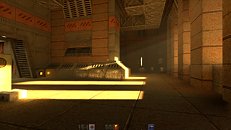Tuesday, March 19th 2019

Quake II Reimagined with Ray-tracing on Vulkan
Christoph Schied reimagined the 1990s cult-classic "Quake II" with real-time ray-tracing, using the Vulkan API and NVIDIA GeForce RTX 20-series hardware exposing the "VK_NV_ray_tracing" extension. Called "Q2VKPT," this game based on id Software's open-source Quake II code, implemented real-time path-tracing to make the lighting more physically accurate. NVIDIA expanded on Schied's work with "Quake II RTX," which is possibly the world's first game that is fully real-time ray-traced.
This NVIDIA rendition of Q2VKPT leverages NVIDIA's RTX for Vulkan to ensure all lighting, shadows, reflections, and other visual effects are ray-traced and denoised using NVIDIA's AI-accelerated denoiser. Unless it somehow scored higher-resolution texture assets from id Software, NVIDIA could also be using a GPU-accelerated upscaler to improve texture resolution. It's also possible that ambient-occlusion methods such as HBAO+ are in play to add apparent geometric detail to some of the surfaces in the game. NVIDIA hasn't made Quake II RTX public yet, although you could take the path-traced Q2VKPT for a spin. You'll need an RTX 20-series graphics card and the latest drivers.
Source:
NVIDIA
This NVIDIA rendition of Q2VKPT leverages NVIDIA's RTX for Vulkan to ensure all lighting, shadows, reflections, and other visual effects are ray-traced and denoised using NVIDIA's AI-accelerated denoiser. Unless it somehow scored higher-resolution texture assets from id Software, NVIDIA could also be using a GPU-accelerated upscaler to improve texture resolution. It's also possible that ambient-occlusion methods such as HBAO+ are in play to add apparent geometric detail to some of the surfaces in the game. NVIDIA hasn't made Quake II RTX public yet, although you could take the path-traced Q2VKPT for a spin. You'll need an RTX 20-series graphics card and the latest drivers.




17 Comments on Quake II Reimagined with Ray-tracing on Vulkan